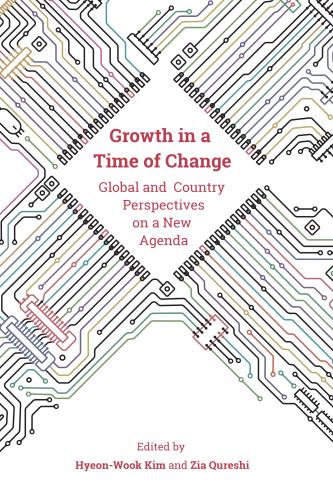This blog is part of a project exploring how the agenda for economic growth is being reshaped by forces of change, particularly technological change.
Productivity growth is a shadow of its former self. It’s one-tenth of what it was 40 years ago in advanced economies, and even emerging economies are struggling to replicate the growth of the past. As the fundamental driver of long-run living standards, weak productivity growth is a serious problem. Lower living standards, bigger budget deficits, fewer jobs, lower wages, and higher inequality await if things don’t improve.
Digital boom but whither productivity?
What is most striking about this period of low productivity is that it coincides with enormous advances in technology. An extra 3.5 billion people have gained access to the internet. The processing power of computers has increased exponentially while their cost and size have plummeted. Smartphones have multiplied, and online businesses have flourished. Email, GPS and advanced software have become widespread. The sharing economy is unlocking the full potential of idle cars and empty rooms and houses. Information and communication technologies (ICT) and artificial intelligence (AI) have reshaped many industries. The accumulated history of human knowledge is now at our fingertips.
Robert Solow famously remarked that “you can see the computer age everywhere but in the productivity statistics.” Economists have put forward a variety of explanations for the so-called “Solow paradox,” each of which implies a radically different path for productivity growth in the future. Our chapter in the just-published book “Growth in a Time of Change” models each of these possible scenarios to explore what the world might look like depending on who turns out to be correct.
Optimistic versus pessimistic scenarios: Generalized takeoff or stagnation
Let’s start with the optimists. Some economists, like the 2018 Nobel Laureate William Nordhaus and Iraj Saniee and his co-authors at Nokia Bell Labs, point to historical data showing long lag times between technological advances and increases in productivity. For these economists, a big surge in productivity is just around the corner.
If the optimists are correct and global productivity growth takes off rapidly, many of the world’s problems go away. Investment, wages, and employment rise sharply. GDP increases and inequality declines. While all sectors experience an investment boom, the durable goods sector experiences the largest increase. The sharp increase in investment sees an increased demand for investment goods, particularly durable manufactured goods and the energy and mining resources required to produce them. Countries that export durable manufactured goods (such as Germany) and energy and mining resources (such as Australia) benefit significantly. Secular stagnation becomes a thing of the past.
But new challenges emerge. The global economy is a closed system, so the resources to finance this boom in investment and production must come from somewhere: either from increased government savings or from reductions in current consumption. If governments don’t act, or if financial market rigidities prevent access to global capital markets, consumption can fall. The shock also triggers transitions that require the redeployment of labor and capital from declining sectors to booming ones. Rigid labor markets and oligopolistic product markets hamper this adjustment. Thus, the full benefits of the boom can be squandered, and its benefits may be short-lived and distributed more unequally between capital and labor.
Now consider the pessimists. Some economists, notably Northwestern University’s Robert Gordon, argue that the technological advances in recent decades won’t deliver the sort of productivity increases that we saw from the inventions of the last century. Facebook and Netflix are great, but they are no match for electricity and indoor plumbing.
If the pessimists are correct and productivity growth in advanced economies turns out to be worse than expected, the future is less rosy. Investment plans will be revised sharply downwards. The capital stock shrinks, unemployment rises, wages fall, and GDP growth takes a hit. A weaker exchange rate partially offsets these effects through a boost to the trade balance as capital flows out of advanced economies in search of higher returns elsewhere, but the net effects are likely to be negative. Emerging economies, which have large catch-up potential for productivity growth, may benefit in this scenario of weaker productivity in advanced economies. Although they suffer reduced export demand, they benefit from an investment boom as capital flows into their economies and global interest rates fall. Weaker trade balances partially offset this adjustment in global capital markets, but the net effect is a boost to GDP.
Mixed scenarios: leading and lagging economies and industries
Not all economists take an all or nothing approach when it comes to the future of productivity growth. Some expect a more asymmetric path. Harvard’s Marc Melitz, for example, sees the answer to the productivity paradox at the firm level. While some firms have been highly productive, their effects have been dragged down by laggard firms. The OECD has found that “frontier firms” have consistently achieved high rates of productivity since 2000, more than six times that of laggard firms. There is similar evidence at the industry level. John Fernald, from the Federal Reserve Bank of San Francisco, shows that ICT productivity gains have been concentrated in specific industries, while other industries have lagged in adopting these technologies.
Our results confirm warnings in the popular media: Firms and industries that fail to invest in emerging technologies will be left behind. But there is more to the story. In a scenario where the services sector experiences a productivity surge, it benefits more than other sectors through increased investment, production, and employment. But other sectors that feed inputs into the surging sector (and countries in which those sectors are dominant) also benefit. Economies that have the largest services sectors, such as Japan, experience the biggest long-run increases in GDP, employment, and investment in this scenario. Capital inflows to these economies mean they also experience the largest partially offsetting appreciations in their real effective exchange rates and the largest declines in their trade balances, but they remain net beneficiaries.
Finally, we explore what happens if productivity increases only in countries that are investing heavily in research and development, especially in AI, such as the United States, the major European economies, Japan, China, and Korea. Unsurprisingly, GDP increases in countries experiencing the productivity boom as they draw in global savings to finance increased investment, consumption, and production. Their trade balances worsen as their exchange rates appreciate, but the net effects for GDP, wages, and employment are substantially positive. But it’s not all bad news for the rest of the world. Although most see a fall in investment and production as capital moves into the booming countries, economies that feed inputs into the investment and production booms in the frontier economies are taken along for the ride.
The particular case of the euro area
But there is a warning for the euro area. When your trading partners have a productivity boom and you miss out, a floating exchange rate softens the blow by automatically depreciating and boosting your exports. But if you and your trading partners share the same exchange rate, this important automatic stabilizer is removed. If France and Germany are the only euro area countries which experience the boom in productivity, not only does the rest of the euro area miss out on the boom but the appreciated euro hurts their exports. This underscores the value of floating exchange rates and sharing technology, particularly through trade. But for countries that share the same exchange rate, it underscores the importance of having deeper fiscal integration and coordination: less spending in booming economies and more spending in nonbooming economies.
Flexibility and openness are key
Our results show that the future will be shaped by what happens next to global productivity growth. Unfortunately, what happens next remains hotly contested. What are policymakers to do in the face of such uncertainty?
The best response to uncertainty is flexibility and openness. If productivity takes off, flexible product, capital, and labor markets in the context of openness will be critical to facilitating the necessary transitions and enjoying the full benefit of the boom. If the boom is happening in neighboring economies, flexibility and openness are key to tapping into those benefits. If the pessimists are right and there is no boom, reforms to boost flexibility and openness will be key to boosting productivity in the first place. As the Chinese proverb tells us, “The best time to plant a tree is 20 years ago. The second-best time is now.” The same is true for structural reform.








Commentary
The future will be shaped by what global productivity growth does next
March 2, 2020